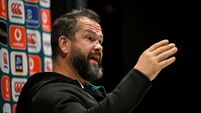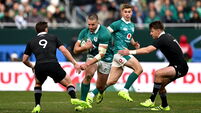Irish in Pole position for Euros
A visit this week to the Trojmiasto – the tri-city area on Poland’s Baltic coast – left a terrific impression of what will be the Irish team’s home from home this June. You could call it the Mars Bar effect: the Irish will work in Gdynia, rest in Sopot and play in Gdansk (against Spain), as well as using this tournament base in the north for flying visits to and from Poznan, 300km to the south, for the games against Croatia and Italy.
All other journeys, at least for the duration of the group stage, will be short hops – Sopot is just a 20-minute local train ride from Gdansk, and Gdynia a further 15 minutes along the coastal line.
Having made the two hours and 20-minute flight from Dublin to Gdansk’s Lech Walesa Airport, itself only 15km west of the city, our recce began with a visit to the home of Polish Second Division side Arka Gdynia. An impressive new 15,000 all-seater – think Tallaght Stadium on steroids — this will be Ireland’s Euros training ground and, apart from June 5, when their inaugural session will be open to the public, it’s the venue where Giovanni Trapattoni and his charges will daily roll up their sleeves and get on with the important work of match preparation away from prying eyes.
Then, for rest and recreation, they’ll repair back to Sopot, the place that puts the charm into the Tri-City bracelet. The Polish Cannes of the 1920s, this compact and predominantly low-rise resort and spa town still retains heaps of period charm, even though it is now the country’s most popular summer destination, and draws increasing numbers of tourists from abroad. Either side of the town’s signature wooden pier, long sandy beaches stretch one way towards Gdynia and the other to Gdansk while, in peak season, the town itself buzzes with nightlife, most of it centred around the pedestrianised Monte Cassino Street which, lined with bars, restaurants, cafes and shops, slopes down to the broad plaza right in front of the beach.
Given that Ireland are only playing one game in Gdansk – the match against Spain on June 14 — it’s not at all clear yet how many supporters will base themselves on the Baltic coast, as opposed to Poznan, but those who opt to do so, or even just manage a brief visit, are sure to fall in love with Sopot.
Despite all of its attractions, or more precisely because of them, the wisdom of basing the players here is another matter. The Irish team’s hotel, the five-star Sheraton, faces onto the beach and is just a stone’s throw from the main drag, meaning it’s located right in the thick of the high Trapattoni was clearly happy to make an affirmative call on Sopot so we have to assume he knows what he’s doing, especially bearing in mind that he has already had occasion to lay down the law over breaches of curfew and other disciplinary issues.
Ultimately, of course, responsibility will rest with the players, and you’d like to think the serious business of European Championship competition will be enough to so concentrate minds.
For players and supporters alike, June 14 is when the focus will be entirely on the football, as Ireland take on reigning world and European champions Spain in the amber-coloured PGE Arena in Gdansk. But the city is well worth investigating in its own right, especially for those with even a passing interest in two of the major events of 20th century history.
For it was here that the first blows of World War II were struck, when a German battleship shelled the harbour on September 1, 1939. Thus began one of the darkest chapters in the story of humankind, as Poland first fell to the Nazis, becoming the focal point for the horrors of the ‘Final Solution’, and then, in a dubious form of liberation, passed into the iron control of the Soviet Union, a span of nearly half a century during which the country lost 25% of its population to the war, saw its cities devastated and then endured decades of authoritarian repression.
But, in a remarkable testament to the power of the people, it was also in Gdansk, in what were then known as the Lenin Shipyards, that the emergence of the Solidarity free trade union movement in 1980 helped sowed the seeds of the end of an empire. Within ten years, Poland was installing the first non-Communist government seen in Eastern Europe since the war and, astonishingly, the Soviet Union itself was well on its way to passing into history.
Although 95% of the city was damaged during WWII, large parts of Gdansk have been beautifully restored, and the old quarter around the waterfront is especially atmospheric. Football might be the reason so many are heading to Poland in June but even our little two-day visit to one small part of it this week was enough to confirm that this is a country which has so much more to offer the interested visitor.












